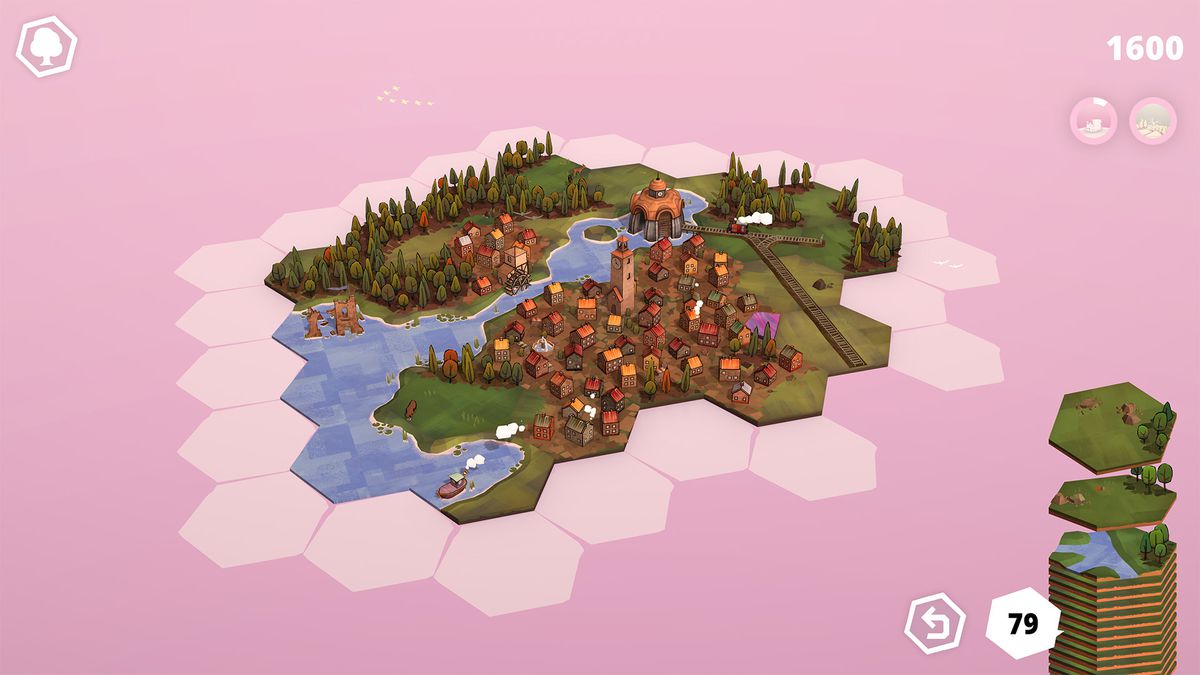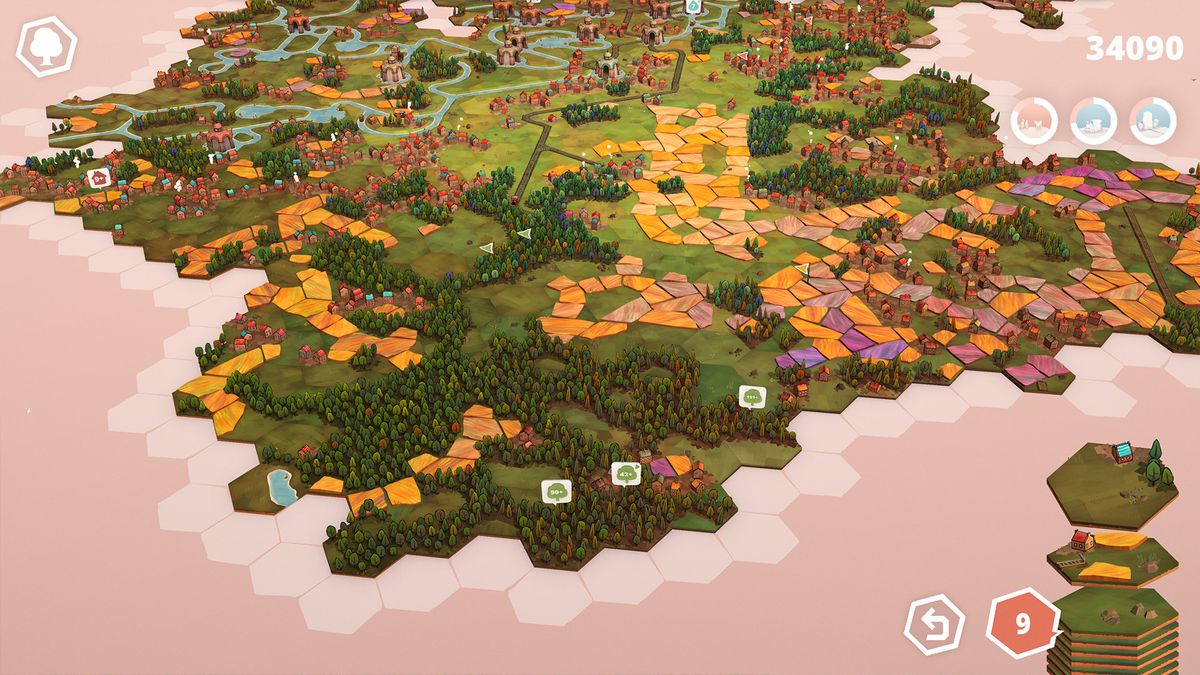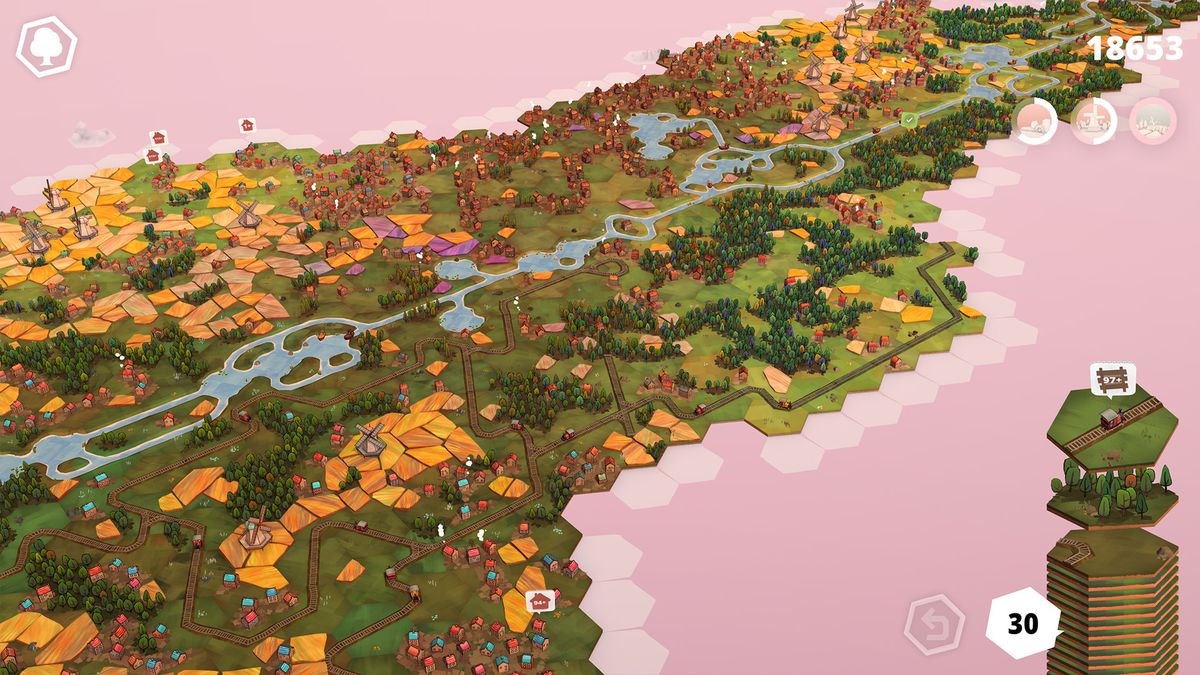Dorfromantik review: a blissful, minimalist chill-out game

The German word “dorfromantik” can be literally translated as “village romanticization.” Its real meaning is more ineffable. In a recent interview with Eurogamer, the developers of Dorfromantik (the game) said the word was “usually used to describe the kind of nostalgic feeling you get when you long to be in the countryside.” Dorfromantik is a state of mind.
This is the perfect name for this chill-out, relaxing game that just came out of an early access year. Dorfromantik is a peaceful game of tile placement: a sort of minimalist, meditative Catan. You build a landscape from hexagonal tiles, creating pine forests, patchwork fields, meandering rivers, spidery train tracks, and higgledy-piggledy little red-brick towns. (No roads, though.) And that’s it. You don’t have to worry about resource production and cost — there is no competition, population or politics. There are no winners, losers, or any other considerations. You are scored purely on how well your tiles match up. Your only goals are harmony and beauty.
Playing Dorfromantik is relaxing. It can even be described as aesthetically cleansing. It is a beautiful and playful way to express your imagination. This is a lovely place. Time doesn’t pass here, and nobody needs anything from you. There is no need to count down as you think about placing the next tile. Take as much time as you want. It’s just as easy to play the game in five minutes while you work sprints, as it is over three hours of blissful relaxation.

Image: Toukana Interactive
None of this is to say that Dorfromantik is aimless or frictionless, however. In fact, it’s quite tightly shaped and controlled. Toukana, a team of four students in game design from Berlin, combines elements of puzzle and strategy games with a clean, well-judged design.
The tiles that you place come from a random stack which is always shrinking. You can earn more tiles through quests to help you keep your game moving, grow your landscape, and increase your score. When you place certain tiles, these quests ask you to combine ever more of the five elements of the landscape: hundreds of houses and water tiles, thousands of trees, and many other tiles. One tile might ask to be joined up to at least 36 other houses, say, while another might require you to gather exactly 13 houses and no more. On completion, some quests raise a flag that rewards you with even more tiles if you successfully close out the town or forest or waterway by surrounding it with other landscape elements so it can’t be expanded any further.
This beautifully simple rule set has ramifications — and to Toukana’s immense credit, those ramifications operate aesthetically as well as in the realm of game balance. Dorfromantik encourages care and strategy, but discourages optimization. It is impossible to succeed with this game if you build a massive metropolis at one end, then a forest at the other, and finally a vast farming field in the third. You will be surprised at the unexpected additions to your landscapes as you complete every quest. It is an extremely simple and well-designed system, which can produce organic results. This is an amazing feat.

Image: Toukana Interactive
The biggest challenges, initially, seem to be posed by the rail and river tiles, which can only be placed next to others of their kind or adjacent to specific terminal points. These can easily create blockages to the expansion of your map as you wait for the “ideal” tile to turn up in the stack. Unsightly knots and gaps appear, in place of the steady, even flowering that you’re instinctively looking for. The rivers and railways can introduce a niggling note of frustration to Dorfromantik‘s calm and satisfying mental tune — but the game would probably be too easygoing without them.
After my first few games of Dorfromantik, the more I learned about the game’s design and tried to engage with it, the worse I would do. My scores kept going down; my stack kept running dry. Was there something else going on? It was too difficult to play the system. I was lumping too many quests together — four or five forest quests in a single body of trees — aiming for efficiency, but in doing so, breaking the game’s steady rhythm. This is not a game of ambition. It can be hard for a mind trained on video game reward systems to break the habit of escalation and learn its languid pace.
I eventually slowed down. I paid less attention to quests and more to tile-matching. You score points for matching the edges of tiles: tree to tree, house to house, grass to grass, and so on. A perfect match along all six edges rewards you with 60 points and an extra tile. More to the point: It looks better. Once I made harmony rather than efficiency my goal, Dorfromantik met me halfway; my scores were better, my runs longer, my maps more beautiful.

Image: Toukana Interactive
This play style is reinforced by one of the subtlest and best additions of the 1.0 update, which highlights matching edges more clearly and gives perfect placements a satisfying pop. Elsewhere, there are new music tracks, all belonging to the genre “extremely tasteful ambient that sounds OK with cows mooing over it.” You can now track more of the meta-goals that reward you with new tile types and cosmetic customizations, including the lovely seasonal “biomes.” And there are several new ways to play, alongside the Classic and anything-goes Creative modes that were already present in early access.
Quick Mode, for one, has a hard limit of 75 tiles and takes somewhere between 10 minutes and half an hour to complete. Hard Mode allows you to fit more tiles and has less quests. You can play with probabilities, quests and other parameters in Custom Mode. Then you can share your settings and the seeds for the tile stack with other players. Monthly Mode is my favorite. It has a set seed with a custom game configuration that changes every month. This should make it a great place to have fun and challenge the community on the leaderboards.
This is all welcome, and it makes Dorfromantik a more complete and rewarding experience. But really, this is one of those games for which early-access status was a bit of a misnomer, not because it had no room to improve or features to add, but because its premise was so fully, perfectly realized from the start. It would be ruined if you tried to add too many things or disturb the delicate balance of friction and flow between logic and naturalism. But the Toukana team knows better than that. The Toukana team is at ease, walking through the country of their minds.
Dorfromantik is out now on Windows PC. The game was reviewed on PC using a download code provided by Toukana Interactive. Vox Media has affiliate partnerships. These do not influence editorial content, though Vox Media may earn commissions for products purchased via affiliate links. You can find additional information about Polygon’s ethics policy here.
Source: www.polygon.com